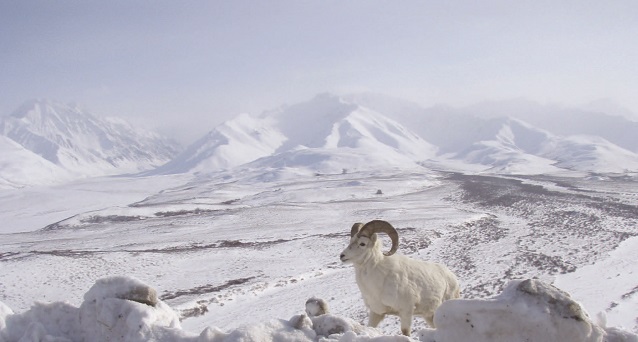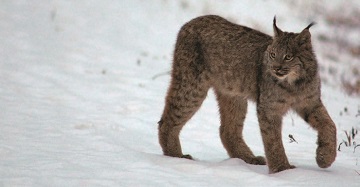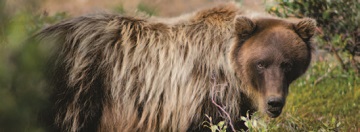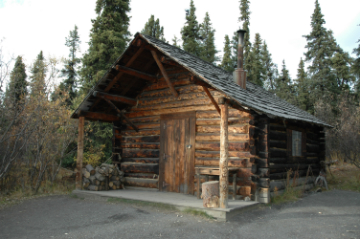
NPS photo
When Charles Sheldon’s envisioned a national park to protect the Dall’s Sheep and other wildlife and their habitat near the tallest mountain in North America in the years prior to 1917, he couldn’t have known what challenges would face the expanded Denali National Park and Preserve 90+ years later.
In late 2009, Denali’s new strategic document, the Resource Stewardship Strategy (RSS), was approved by the Alaska Regional Office. The RSS provides guidance for the research, resource management, and resource education programs of the National Park Service (NPS) at Denali over the next 20 years.
Denali is the second unit in the National Park system—and the first park with extensive natural resources—to complete an RSS. Thus, Denali’s RSS document may serve as a prototype for other large parks managing extensive natural and cultural resources. Denali has long recognized the importance of information-based decision making, as well as the need to increase the public’s understanding of park issues, through a science- and scholarship-based approach. Denali has operated using its Resource Management Plan (1998), but in 2001, the NPS instituted a new planning process through its Management Policies, which changed the principal program document for resource management from the Resource Management Plan to the Resource Stewardship Strategy (Director’s Order 2-1).
What is a Resource Stewardship Strategy?
The RSS is a bridge between the desired conditions in a park’s General Management Plan (GMP) and the goals and implementation actions determined through park planning. In the RSS process, parks identify indicators of resource condition, establish targets for each indicator, and assess the current condition of these indicators. “Comprehensive Strategies” are developed to fill any gaps in resource knowledge; to determine indicators and targets, if unknown; to determine resource condition; and to plan studies or research that help the park achieve or maintain desired conditions.
The scope of an RSS is the desired conditions of the park’s natural and cultural resources, and the desired conditions for visitor experience that directly depend upon resources conditions. The RSS provides the park with a strategy for investing both human and fiscal resources in the stewardship of park resources. It also reports accountability toward attaining and maintaining desired resource conditions in the park.
Development and updating Denali’s RSS
Denali’s RSS team followed the national guidance for RSS development, but adopted new approaches for Denali’s extensive natural resources. Denali’s RSS is a document that will be reviewed and updated at periodic intervals, incorporating new findings and understandings.

NPS photo
Resources and values, and status of knowledge
Denali’s resources and values (see panel at left) were incorporated from a review of enabling legislation for the “old park,” the Alaska National Interest Lands Conservation Act or ANILCA (1980), and Denali’s GMP (2006). Fundamental resources and values reflect the park’s purposes and significance. Other important resources and values are ones the park is mandated by Congress to protect, but are not the reason the park was established. The desired condition for each value was derived from the documents reviewed.
Staff assembled a status of knowledge in relation to desired condition for many aspects of physical, biological, and cultural resources, as well as park visitation and the human environment in and around the park. Some resources have extensive data while some areas need additional information.
Indicators and targets for desired condition
Denali’s RSS team selected 119 indicators. Targets were able to be set for 80 indicators and current condition is known for 46 indicators. Research and planning are needed to identify the targets and current condition for the remaining indicators and to identify some indicators related to visitor experience.
Comprehensive strategies
Denali’s RSS team developed 19 comprehensive strategies (see panel at right) and 99 associated projects that address one of three needs: (1) monitoring and managing park resources and visitor activities to assure that targets for each indicator are achieved, (2) filling data gaps necessary to define and evaluate indicators and targets for park resources, and (3) implementation of research or resource management activities required by legislation or the park’s GMP. Each strategy and project are arranged on a timeline with a budget with a start year of 2008. Projects were prioritized into higher, medium, and lower bands. The comprehensive strategies were scrutinized during “expert review.” The NPS Alaska Regional Director signed the approved document.
Implementing Denali’s RSS
Funded projects will proceed through planning and NEPA compliance. At regular intervals, park staff will review and adjust the RSS. Existing specific park program plans such as the Subsistence Management Plan, Museum Management Plan, and the Bear-Human Conflict Management Plan will continue to provide the details for day-to-day operations.
How to get a copy of Denali’s RSS
The entire RSS is posted on the Denali web site along with a summary document. Printed copies of the summary are also available by contacting the park.

NPS photo
Denali's Fundamental Resources and Values
(1) Wildlife populations, wildlife habitat, and the processes and components of the park’s natural ecosystems
(2) Wilderness character, wilderness resource values, and wilderness recreational opportunities
(3) Scenic and geologic values of Denali and surrounding mountain landscape
(4) Visitor enjoyment and inspiration from observing wildlife in its natural habitat and other natural features

NPS photo
Denali's Other Resources and Values
(5) Historic, archaeological, and ethnographic resources
(6) Subsistence resources and opportunities
(7) Paleontological resources
(8) Air quality
(9) Scientific research, education, and interpretation about natural ecosystems and geological features and processes
Denali’s Comprehensive Strategies
Base Knowledge of Park Resources
Strategy A: Complete biological, physical, and cultural resource inventories for Denali
Strategy B: Develop an understanding of basic ecological relationships necessary for management decisions
Strategy C: Develop the historic contexts necessary to evaluate nominations for National Register significance
Monitoring Resources
Strategy D: Develop and/or implement vital signs monitoring protocols for physical and biological resources
Strategy E: Monitor natural resources that may need management response
Management and Mitigation
Strategy F: Develop and implement plans to monitor and manage vulnerable park resources
Strategy G: Restore and monitor disturbed lands
Strategy H: Determine and monitor visitor carrying capacity by management area
Strategy I: Minimize habituation of park wildlife
Strategy J: Detect, monitor, and mitigate environmental influences external to the local natural ecosystem
Strategy K: Mitigate the risk of wildland fire to park infrastructure and cultural resource sites
Strategy L: Preserve the museum collection and rehabilitate and preserve park historic structures
Strategy M: Monitor and manage consumptive uses of park resources, including subsistence use
Strategy N: Enhance and increase the effectiveness of wildlife protection by deterring illegal activities
Parks and People
Strategy O: Improve estimation of park visitation
Strategy P: Monitor trends in adjacent community populations, land use, and local economy
Data Management
Strategy Q: Develop and implement effective data management strategies
Education and Communication
Strategy R: Facilitate the education of all audiences (external and internal) about resource issues
Strategy S: Develop staffing and infrastructure to enhance bridges between research and interpretation
Last updated: July 28, 2016
